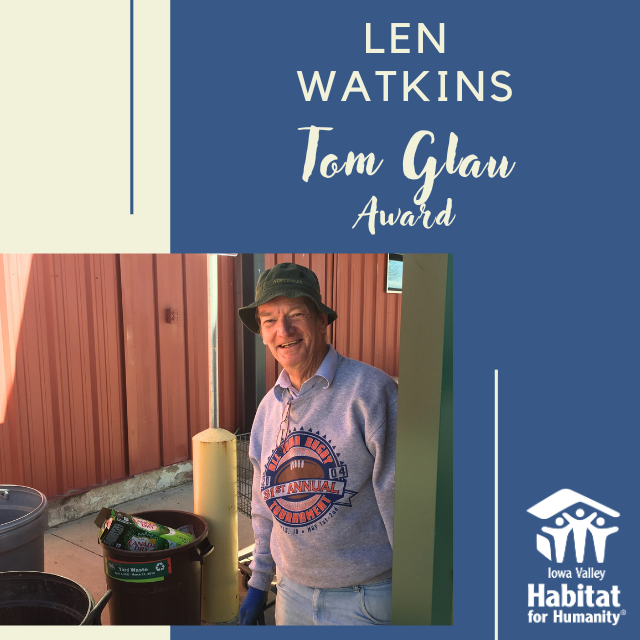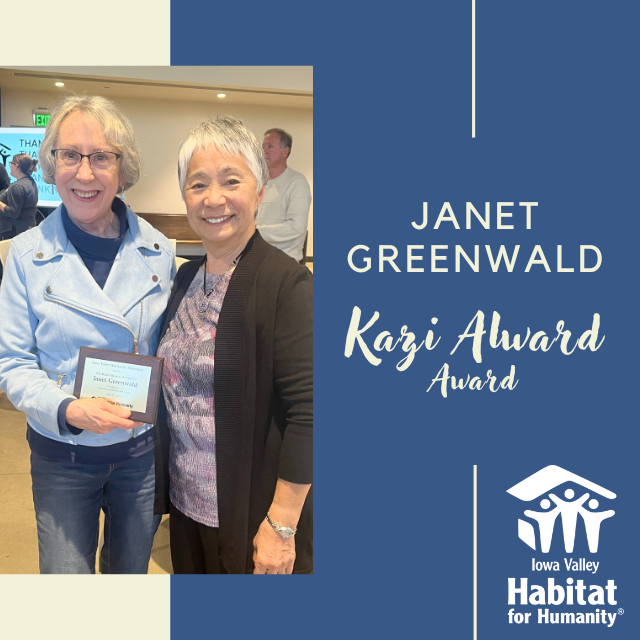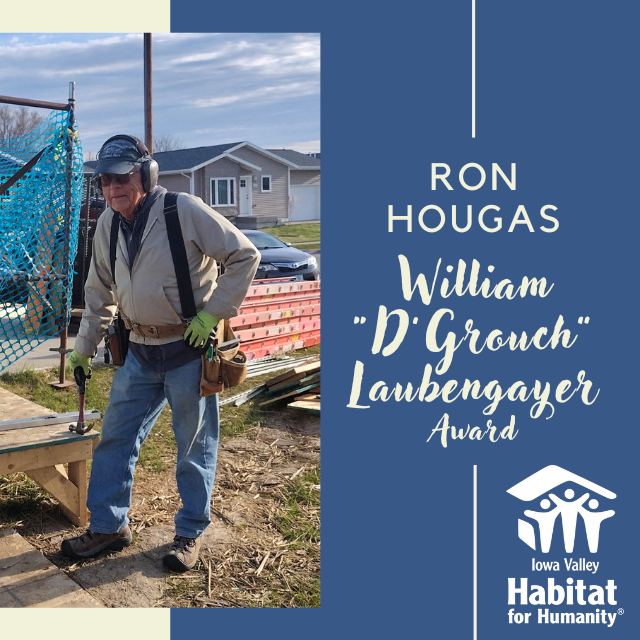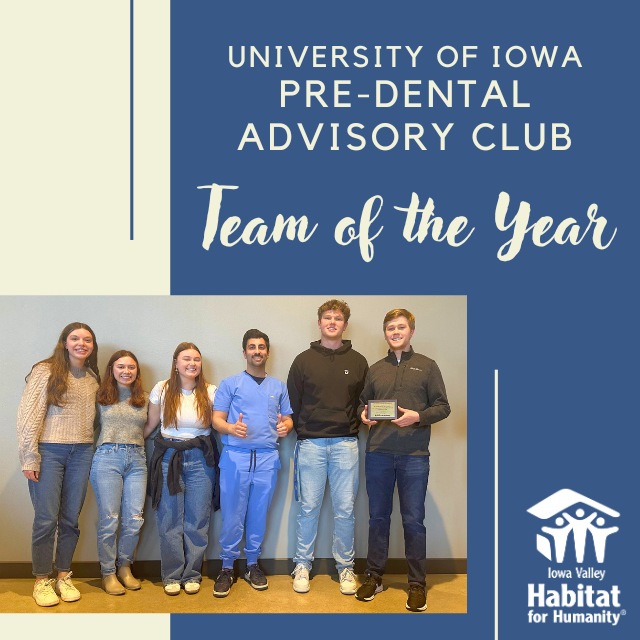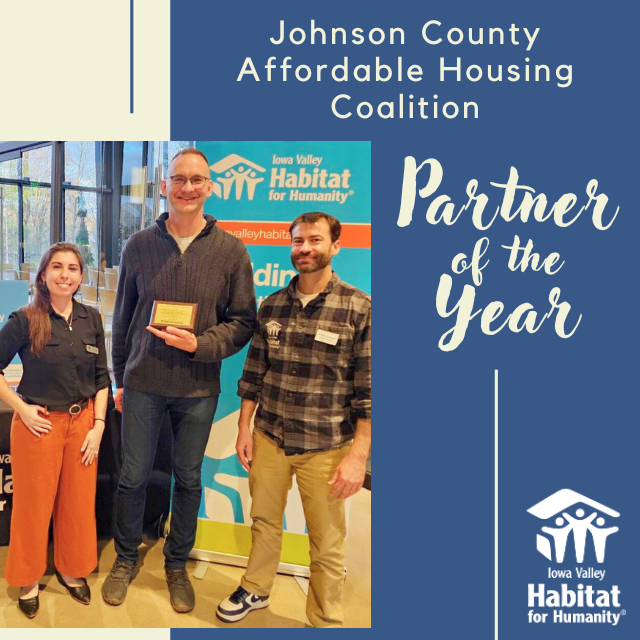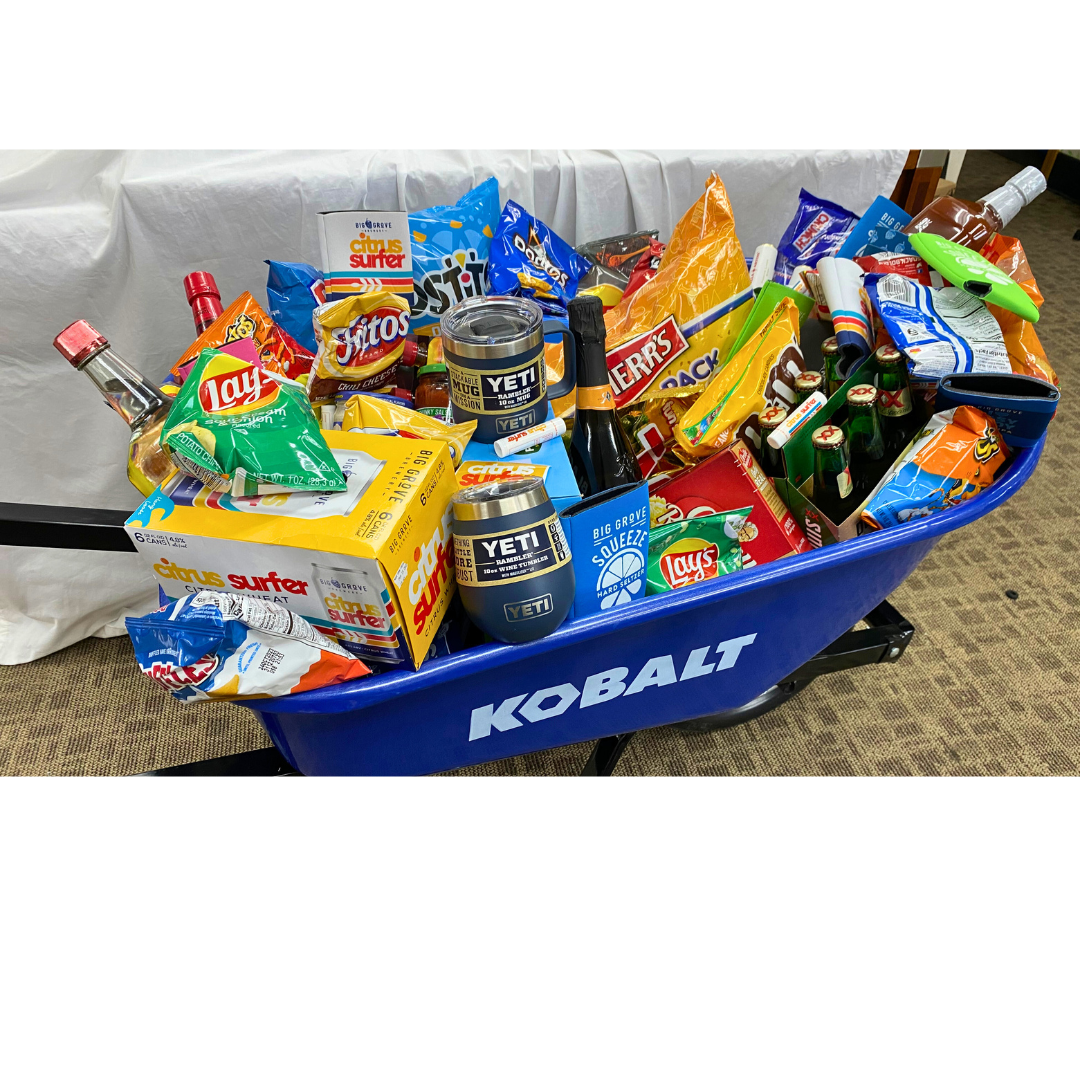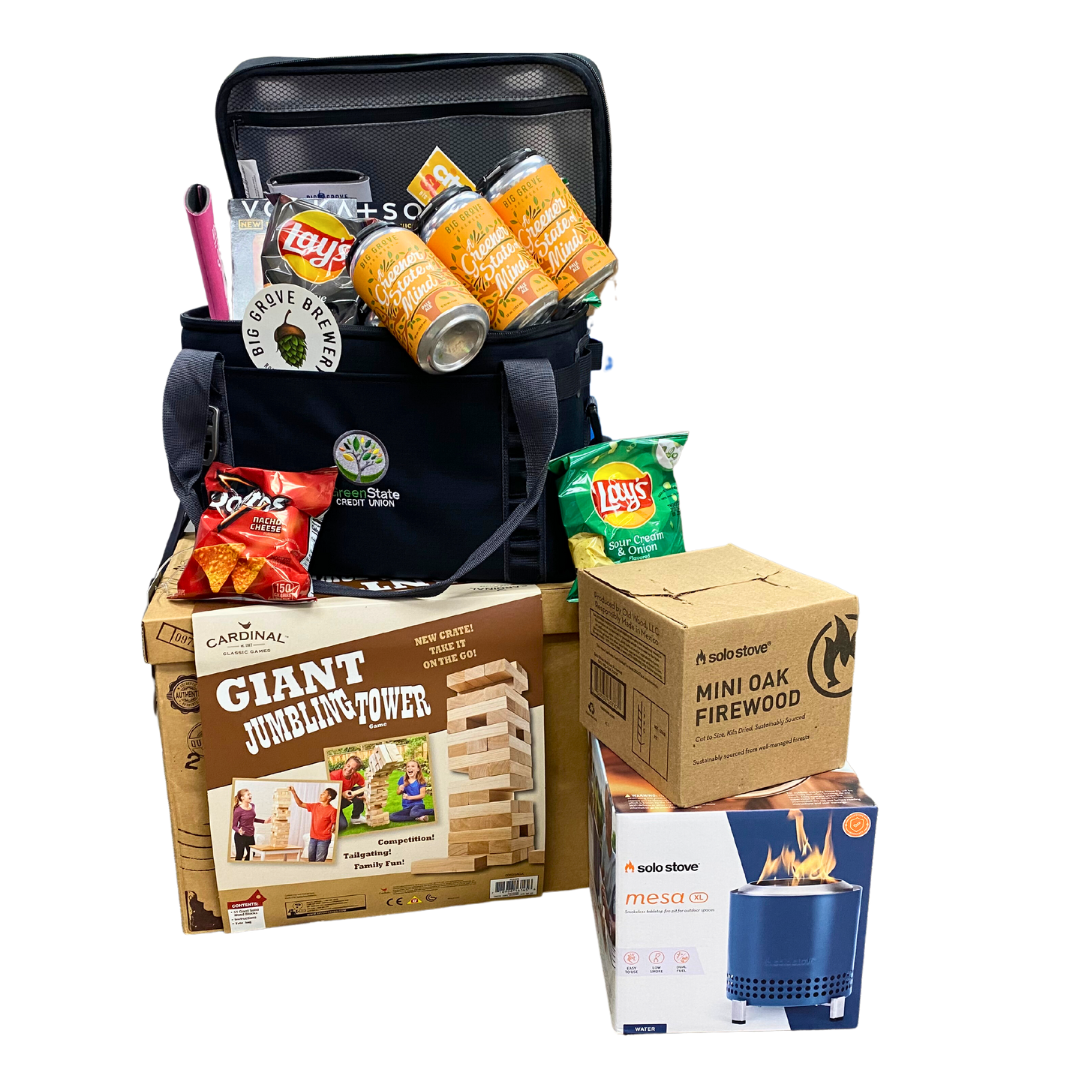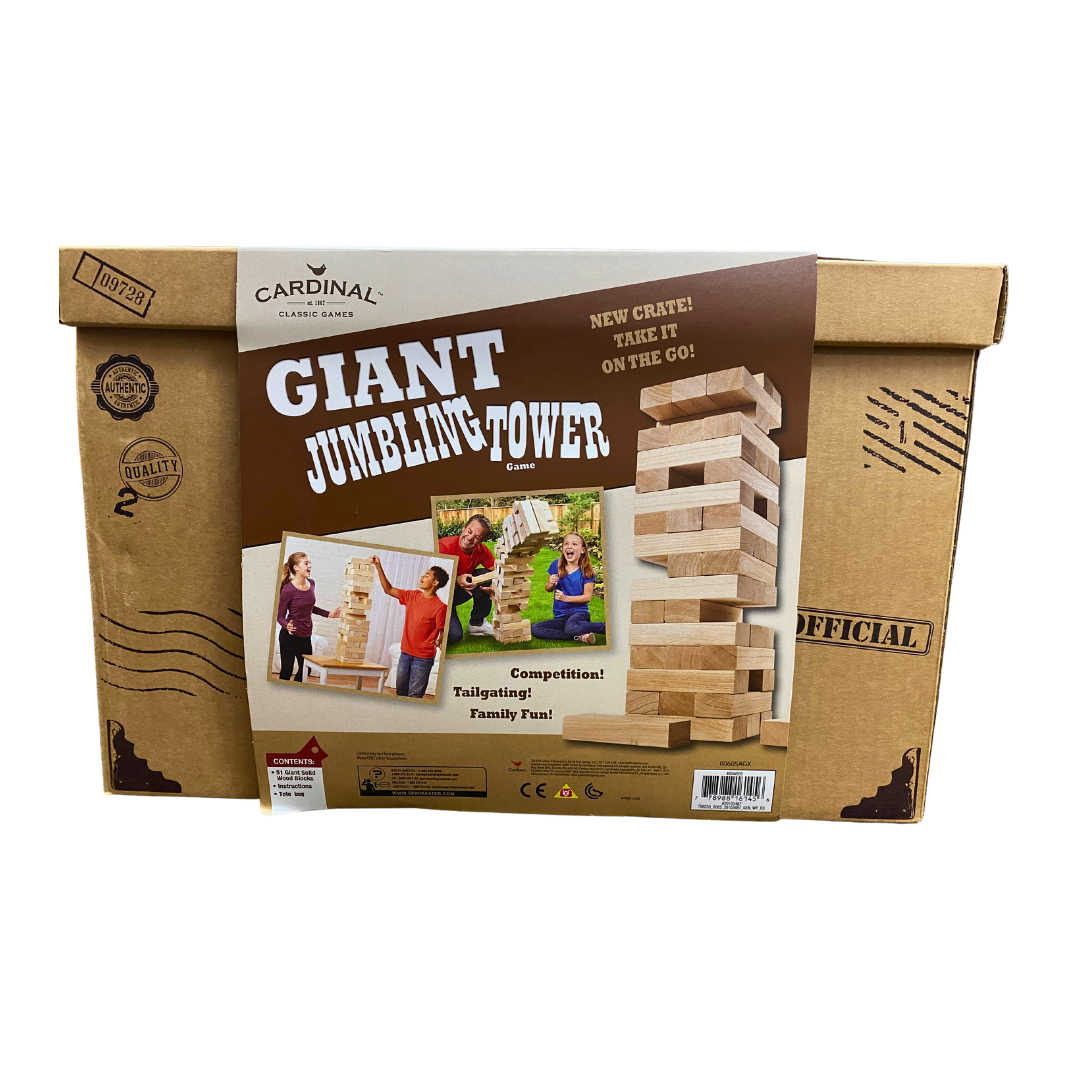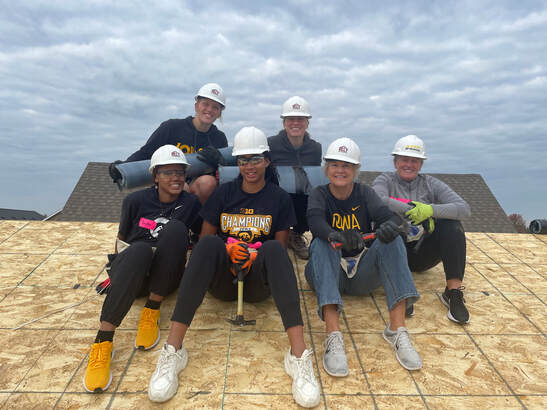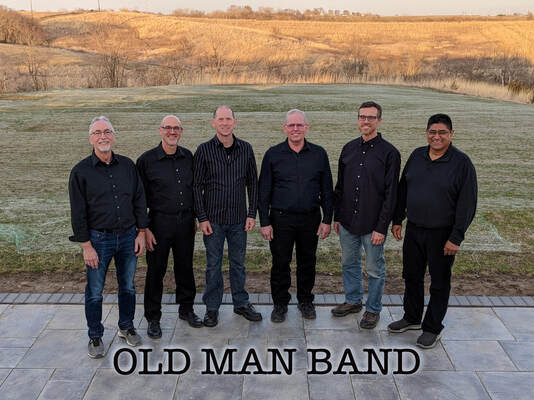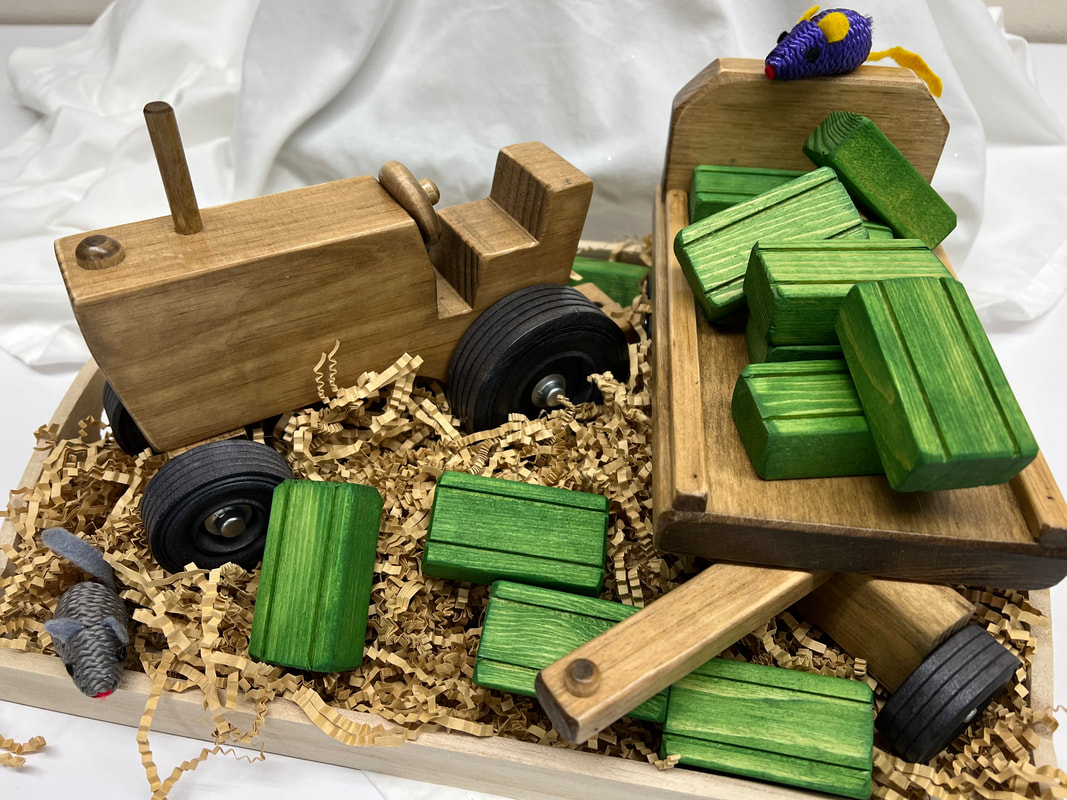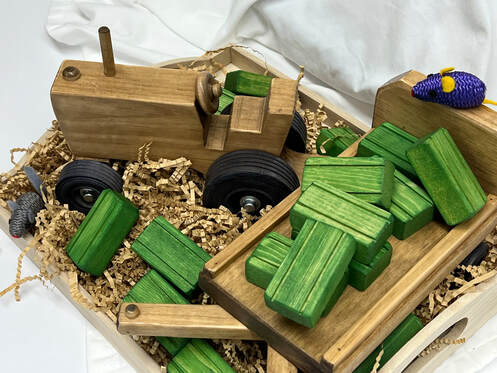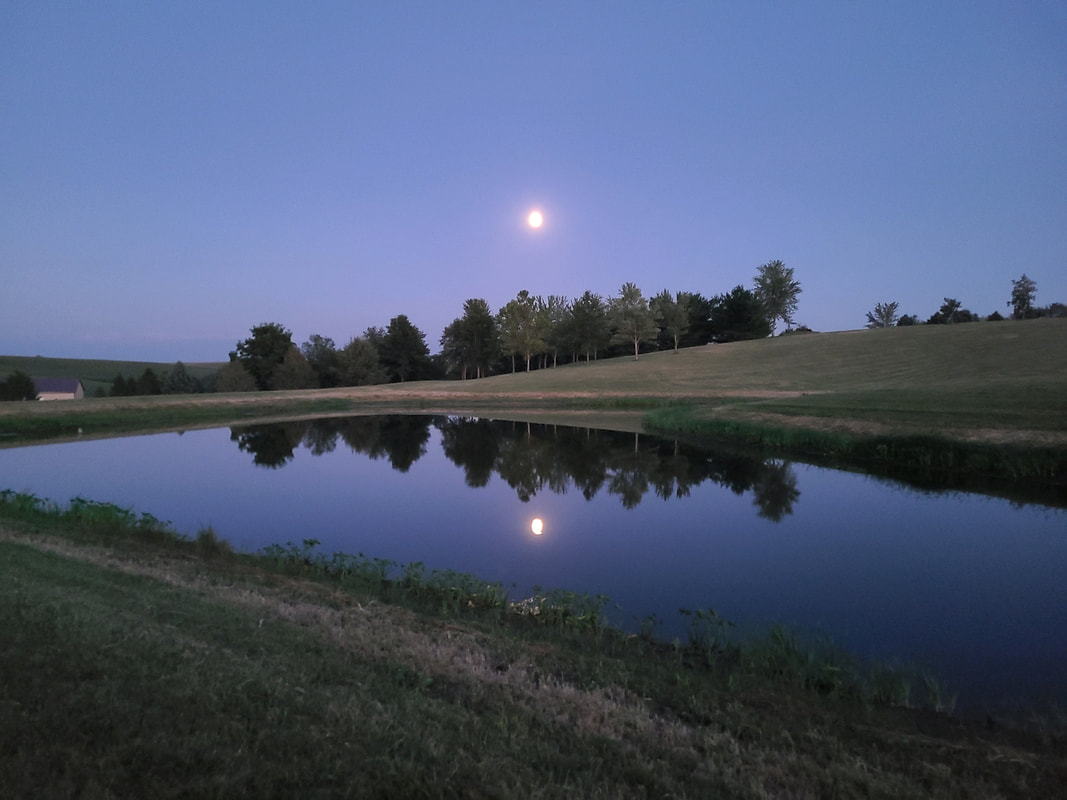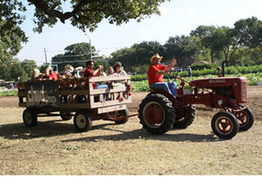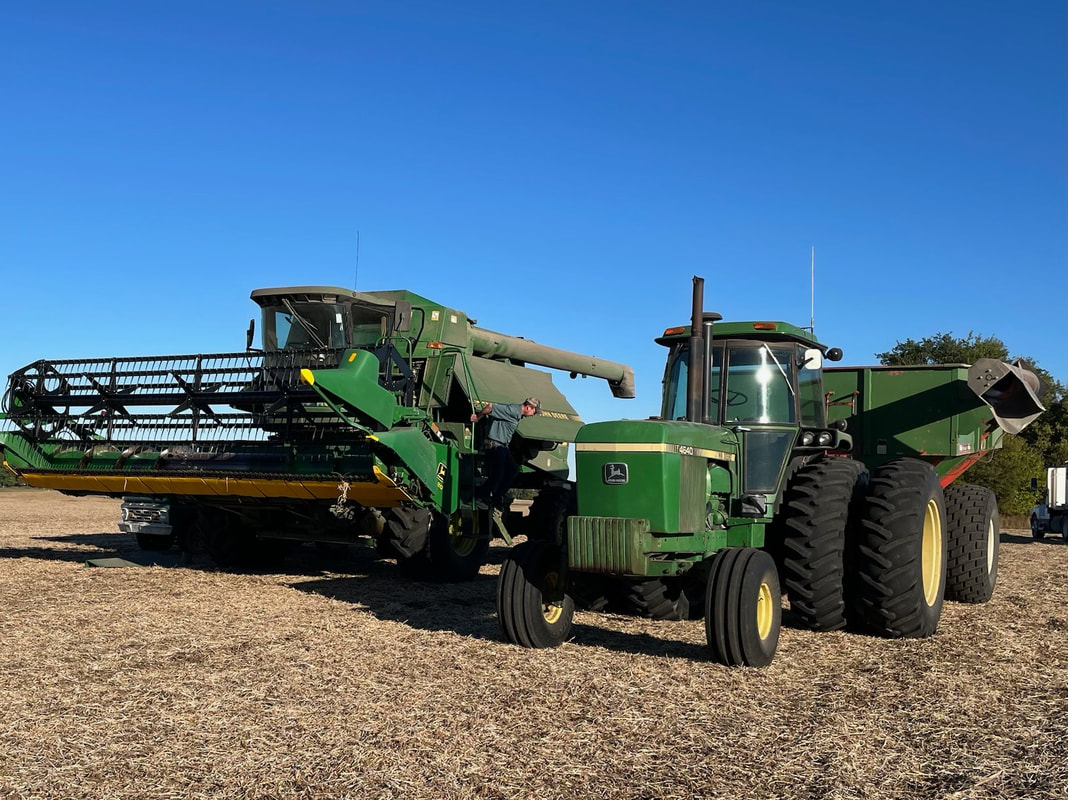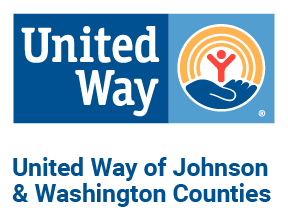 Billie Townsend and the Women Build committee invite you to join them in July for a month filled with events to raise funds and engage the community in Iowa Valley Habitat for Humanity's 14th Women Build project. Check out this lineup of events—there are activities for people of all ages to get involved!
Can't attend our events but still want to show your support? Make a donation to support the Billie Townsend Women Build project!
Thank you to everyone who joined us for Habitat Friends Night earlier this month! This annual celebration of our supporters is an event our entire staff looks forward to every year because it gives us the opportunity to see many of our volunteers, donors, and homeowners. We hope this event conveys the immense gratitude we have for each and every one of you. At this event, we presented awards to several of our supporters for their outstanding service and dedication to the Habitat for Humanity mission. Congratulations and thank you to our 2024 awardees! TOM GLAU AWARD PRESENTED TO LEN WATKINSThe Tom Glau Award is named after Tom Glau, a long term volunteer for the Iowa City ReStore. Recipients are selected for their outstanding service and dedication as a ReStore volunteer. This award was presented to Len Watkins who has volunteered regularly for years helping with donations and organizing the Iowa City ReStore. Len also manages the Cans for Habitat program by sorting refundable deposit cans and bottles that are dropped off at the store. When cans are sorted and bagged up, a truckload is taken to a redemption center and the funds go toward Iowa Valley Habitat for Humanity's programs and services. Len’s support not only recycled more than 300,000 cans and bottles last year, but it also raised over $15,000 for Iowa Valley Habitat for Humanity. KAZI ALWARD AWARD PRESENTED TO JANET GREENWALDJanet Greenwald received the Kazi Alward award at Habitat Friends Night. This award is named after long term supporter, Kazi Alward, and recipients are selected for their outstanding service, kindness, and dedication. Janet volunteers on every home build and has the patience and attention to detail that truly transforms Habitat homes in the final weeks of construction. WILLIAM "D'GROUCH" LAUBENGAYER AWARD PRESENTED TO RON HOUGASThe 2024 D'Grouch award was presented to Ron Hougas. Named for William "D'Grouch" Laubengayer who volunteered countless hours on the construction of 104 Habitat homes, recipients demonstrate ongoing dedication and outstanding service to Iowa Valley Habitat for Humanity. Ron travels around 60 miles roundtrip to volunteer with the IVHFH construction crew and many times up to 3 days a week. TEAM OF THE YEAR AWARD PRESENTED TO UI PRE-DENTAL ADVISORY CLUBCongratulations to the University of Iowa College of Dentistry Pre-Dental Advisory Club for receiving the Team of the Year Award. This award recognizes the group for their outstanding and ongoing service to Iowa Valley Habitat for Humanity. The Pre-Dental Club recruits volunteers for multiple build days each school semester. PARTNER OF THE YEAR AWARD PRESENTED TO THE JOHNSON COUNTY AFFORDABLE HOUSING COALITIONIowa Valley Habitat for Humanity presented the Partner of the Year award to the Johnson County Affordable Housing Colaition in recognition of their outstanding service and commitment to prioritizing safe and affordable housing throughout the Johnson County community. JCAHC staff and volunteers work to provide the public and local housing agencies with valuable resources and education in addition to advocating for the housing rights for Johnson County residents.
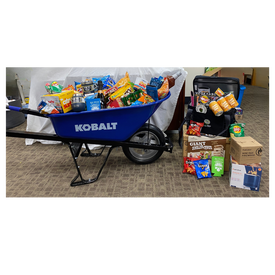 Get ready for your next outdoor party or Hawkeye tailgate! This awesome wheelbarrow is filled to the brim with all the goodies you need - chips, dips, salsa, snacks, alcohol and drink mixes, beer, wine, and more! And thanks to Scheels, we even have a Solo Stove table firepit and mini oak firewood to make some delicious s'mores. The firepit is super cool with its Dual Fuel capability and Signature 360° Airflow, making it a breeze to ignite and enjoy a smokeless fire. Plus, Scheels also included a Yeti brand mug and wine tumbler to keep your drinks nice and chilly. And don't forget your Eddie Bauer insulated cooler from GreenState Credit Union which is already full of some of your favorite Big Grove brews. Oh, and your friends are sure to have a blast playing a giant outdoor game of Giant Jumbling Tower (think Jenga!). So, grab a drink, gather your friends, and let's have an amazing time outdoors! The best part—you can wheel it all away in a Kobalt wheelbarrow donated by Lowe's! Want to learn more about the Solo Stove table firepit? Check out this link. You should also take a look at the specs for the Kobalt wheelbarrow! IVHFH construction staff can't recommend a better quality wheelbarrow! Package includes:
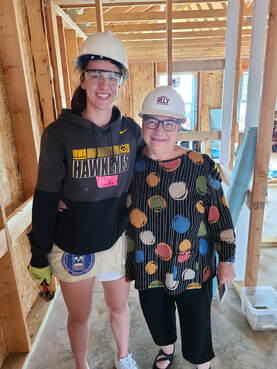 This is an opportunity for our Hawkeye fans to get a one-of-a-kind view of Iowa Women’s Hoops. With this package, one lucky bidder and three of their friends will work with the Hawkeye staff to schedule a day when they get four court-side tickets, four t-shirts, and a pre-game tour of Carver-Hawkeye arena. Where else can you get a behind-the-scenes look as players, coaches, and staff prepare for a game? This is a once in a lifetime opportunity that you can’t afford to miss. Package includes:
Where will you be when the 2023 Big Ten Tournament champions and Final Four participant start their march for the 2024 National Championship? Well, one lucky bidder and three of their friends will be sitting court-side on November 6 as the Hawkeyes start their new campaign. So if you’ve wondered what it is like to sit mere feet away from Caitlin Clark as she launches logo threes, this item is for you! Don’t bypass this chance to see the best basketball team in the country!
Tickets generously donated by GreenState Credit Union  Looking for the perfect entertainment for your next get together? The Old Man Band will perform live at your next party. Dance and sing along to your favorite songs as the Old Man Band makes your next party a memorable one. Bid now and schedule later! Enjoy a performance for up to 3 hours. The band brings all the equipment they need. The only thing they need from the event hosts is an electrical outlet! *Date and times are subject to availability. The winner will work with the band to select a date when Old Man Band is available. Check out this link to the Old Man Band Demo! Enjoy!
The bandmembers’ comfortable banter with each other and the audience just adds to the fun. “It’s ear candy” in the words of one eloquent fan. “You guys are always so much fun! We definitely want you back next year! Put it on your calendar!” -Jackie Bailey, Courage Ride Founder “They always fill the tent and the crowd stays until the very end.” -Nancy Roth, Kalona Fall Festival Organizer
 Is there anything more fun than spending a sunny summer day with 19 of your friends and family eating your favorite BBQ with all of the fixin’s, casting a line in a well-stocked lake, beating your siblings at cornhole, catching a hayrack ride, and wrapping it up by roasting marshmallows? This experience is for those who consider this a perfect day. Mary Mascher will host a party for 20 people at her family farm in rural Johnson County. One lucky bidder will work with Mary to schedule the outing and prepare a menu, then stand back as Mary takes care of the rest. To commemorate your win, you get to take home a tractor and hayrack—okay, they're toys, but they are awfully cute! Toy set includes wooden tractor, hayrack, hay bales, and friendly farm mice. This one-of-a-kind experience includes:
*Limit of 20 guests* **Restrooms available on site** ***To be scheduled for June or July 2024 and date is subject to hosts' availability*** Want an opportunity to experience unmatched hospitality? Long-time Habitat supporter, former member of the Board of Directors, and fantastic cook, Kineret Zabner, is inviting the winning bidder—and seven friends—to enjoy authentic Venezuelan cuisine at her home. Want to have people over to your house, but don't feel like cooking? No problem! Kineret can deliver, but why would you want to miss out on an opportunity to enjoy a meal with a spectacular view from the Chauncy Building in downtown Iowa City?! Whatever your preference, don't miss this chance to enjoy an easy evening of fantastic food, great conversation, and even better company!
The meal includes a big salad for appetizer, pulled beef, rice, black beans, and fried plantains for dinner and coconut flan and berries for dessert. *A delivered meal must be in the Iowa City, Coralville, North Liberty area. “Life is good, especially when you have a classic hotel to live it in.”
Don't miss out on a vacation stay at one of the most historic—and breathtaking—hotels in Wisconsin! This one-of-a-kind hotel is in Fond du Lac, endearingly known as Fondy! The award-winning hotel design features a lobby decorated in vintage fashion, with crystal chandeliers, porcelain-tiled floors, and black and white panels adorning the pillars and doors. “Hotel Retlaw has been restored to its former historical significance with a remarkable renovation completed in 2019. While the hallmark aesthetics of our property remain, contemporary elements can be found throughout, including stylish and unique décor.” -Hotel Retlaw website You might be asking, what is Retlaw?! The hotel’s beloved original owner was Walter Schroeder—Walter spelled backward? Yep! It’s Retlaw! This package includes:
You might be bidding on this one-of-a-kind hotel, but Fond du Lac will not let you down! Guests also enjoy easy access to the best things to do in downtown Fond du Lac from the hotel. Visit, shop, play, and dine along the scenic east shore of Lake Winnebago. From Fond du Lac to Sherwood, find unique gifts and art, salons and spas, restaurants, and cafes, boating and golfing, parks, orchards and farms. There are always great things to do in Fondy! Hotel Retlaw History (taken from the hotel's website): Since the hotel’s opening in 1923, Walter Schroeder (the original owner of the hotel) had a vision to create the Hotel Retlaw as one of the finest hotels in the State of Wisconsin. The eight-story neoclassical hotel in red brick with its cornice and façade detailing shows the attention to detail that was not overlooked in buildings of the era. It’s no coincidence that the name Retlaw, if you haven’t guessed it yet, is his first name backward. While little has changed on the exterior of the hotel over the past 90 years, the interior has undergone several transformations. The original hotel had 265 guestrooms, which was later reduced to 138. In our current design, we have 121 guestrooms, suites, and residential suites. The building has been placed on the National Register of Historic Places by the National Park Service. This is the official list of the Nation’s historic places worthy of preservation. Hotel Retlaw stands today as one of the most richly historic hotels in Wisconsin. Learn more about Hotel Retlaw: https://www.thehotelretlaw.com/ |
|
|
Our Mission: Seeking to put God’s love into action, Habitat for Humanity brings people together to build homes, communities and hope.
Our Vision: A world where everyone has a decent place to live. Our Values: - Demonstrate the love of Jesus Christ. - Focus on shelter. - Advocate for affordable housing. - Promote dignity and hope. - Support sustainable and transformative development. |
We welcome all who believe that everyone needs a decent, affordable place to live. Habitat for Humanity International and its affiliated organizations do not proselytize.
Habitat will not offer assistance on the expressed or implied condition that people must either adhere to or convert to a particular faith, or listen and respond to messaging designed to induce conversion to a particular faith. |







